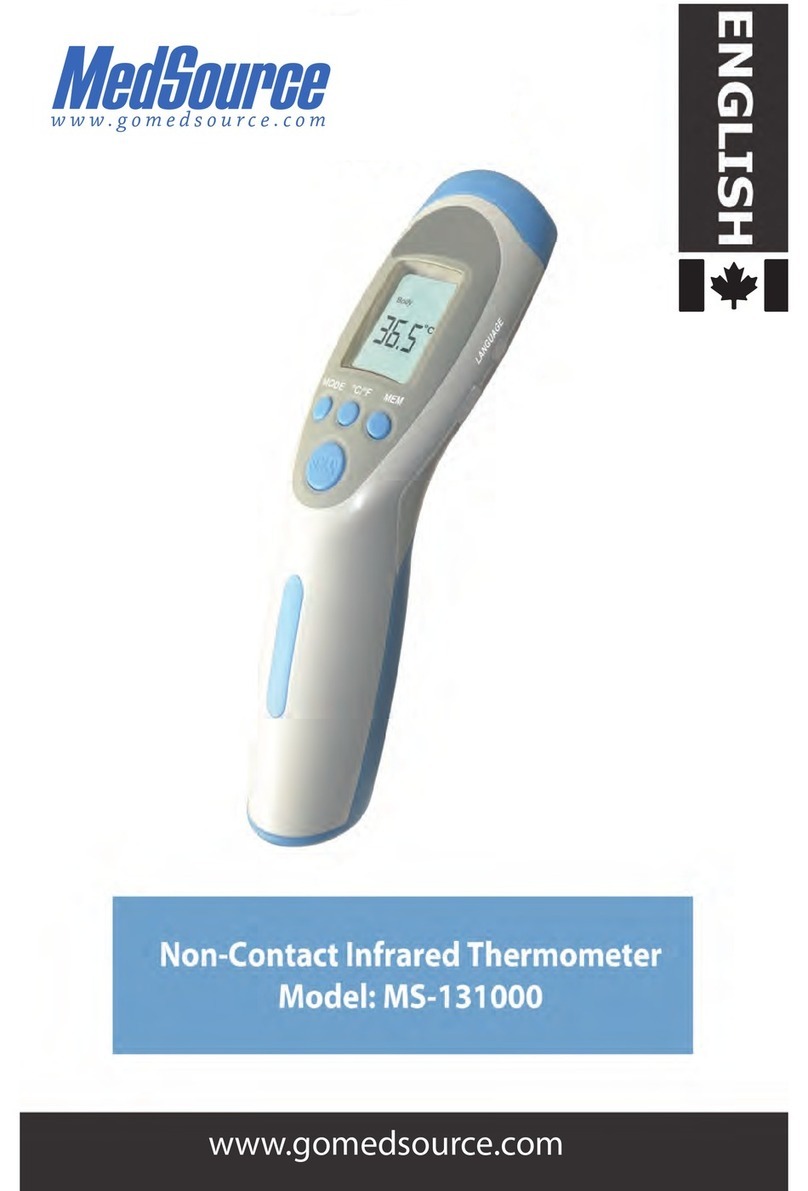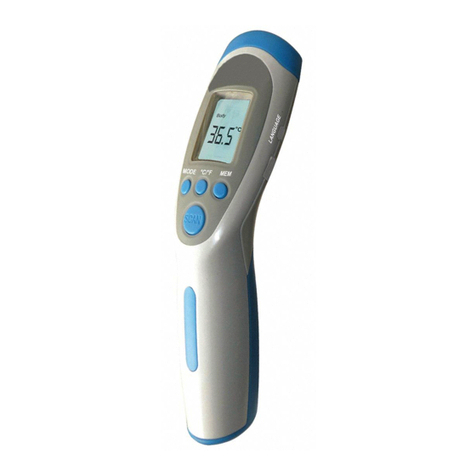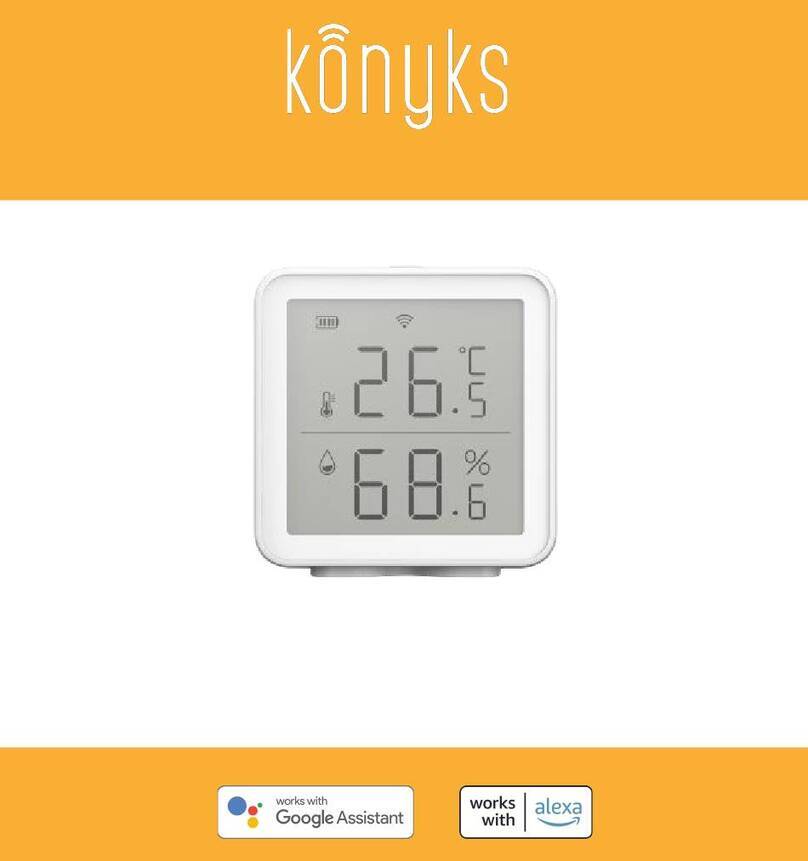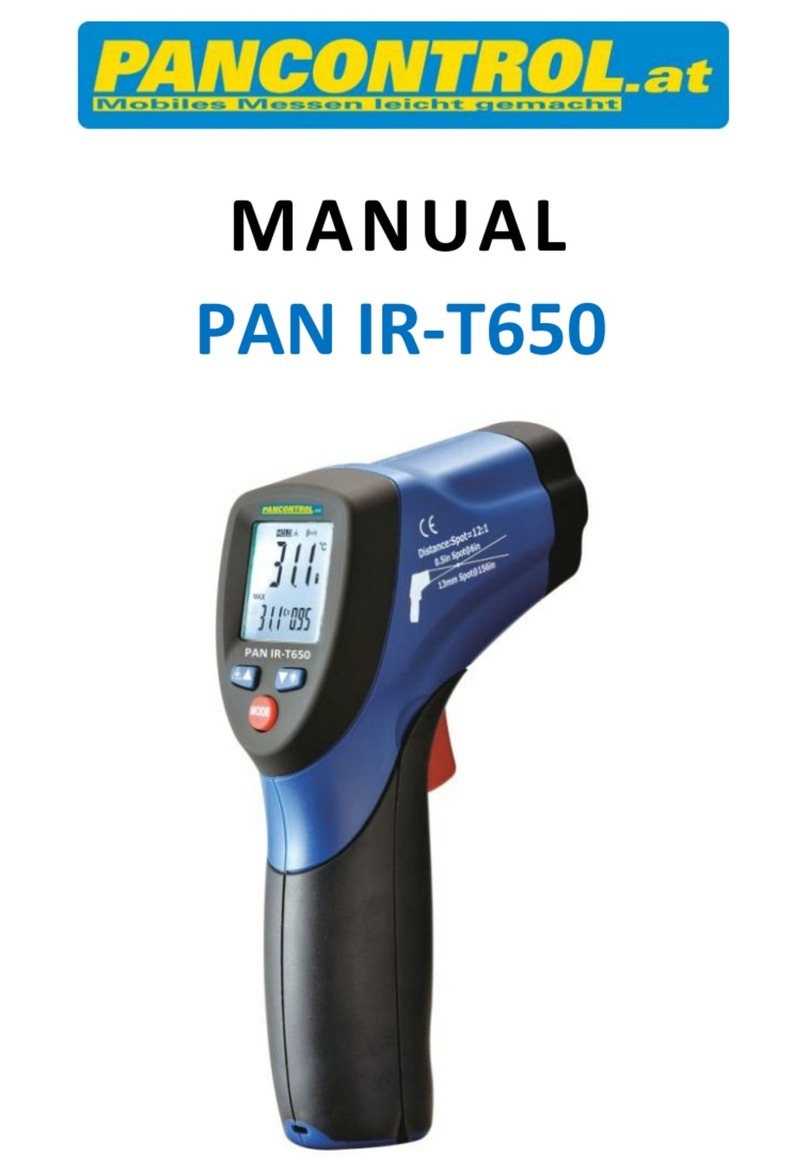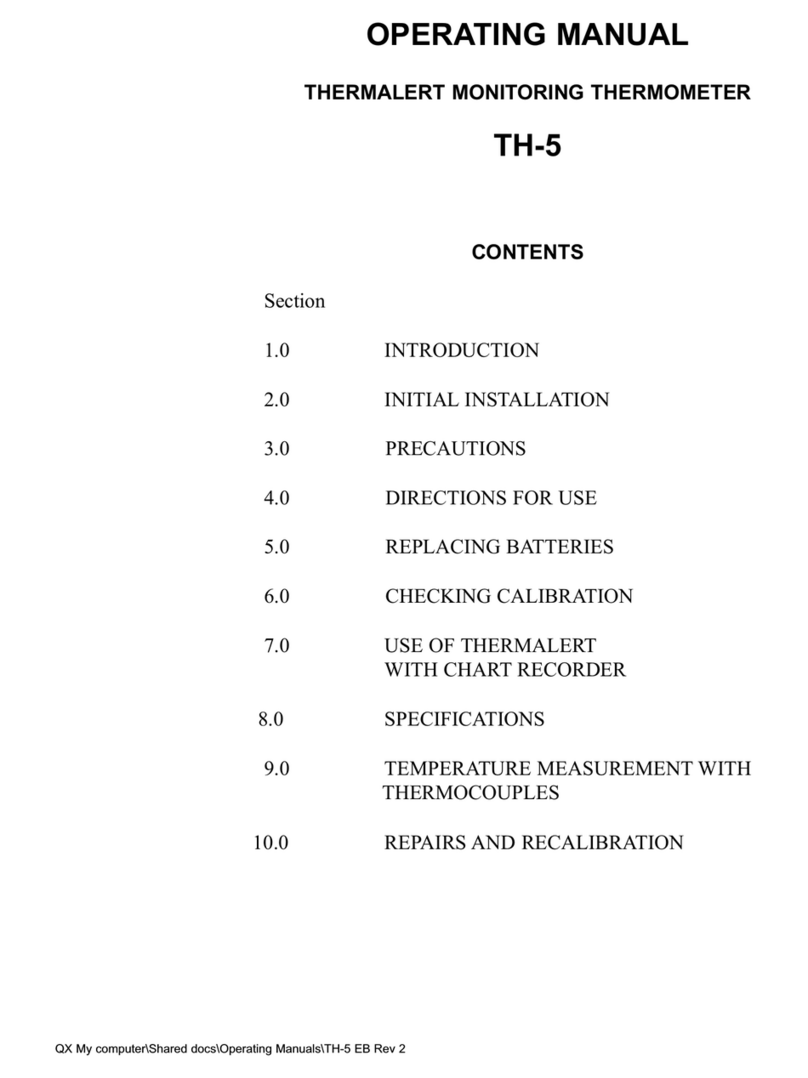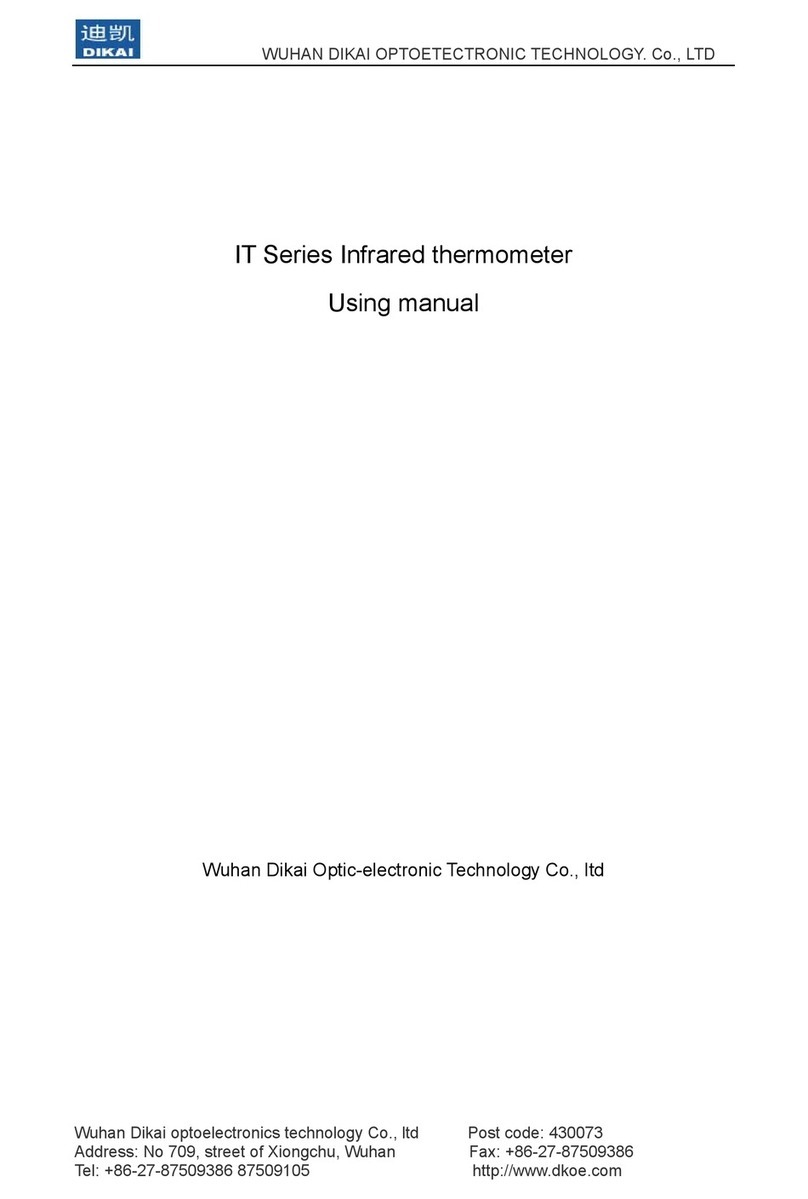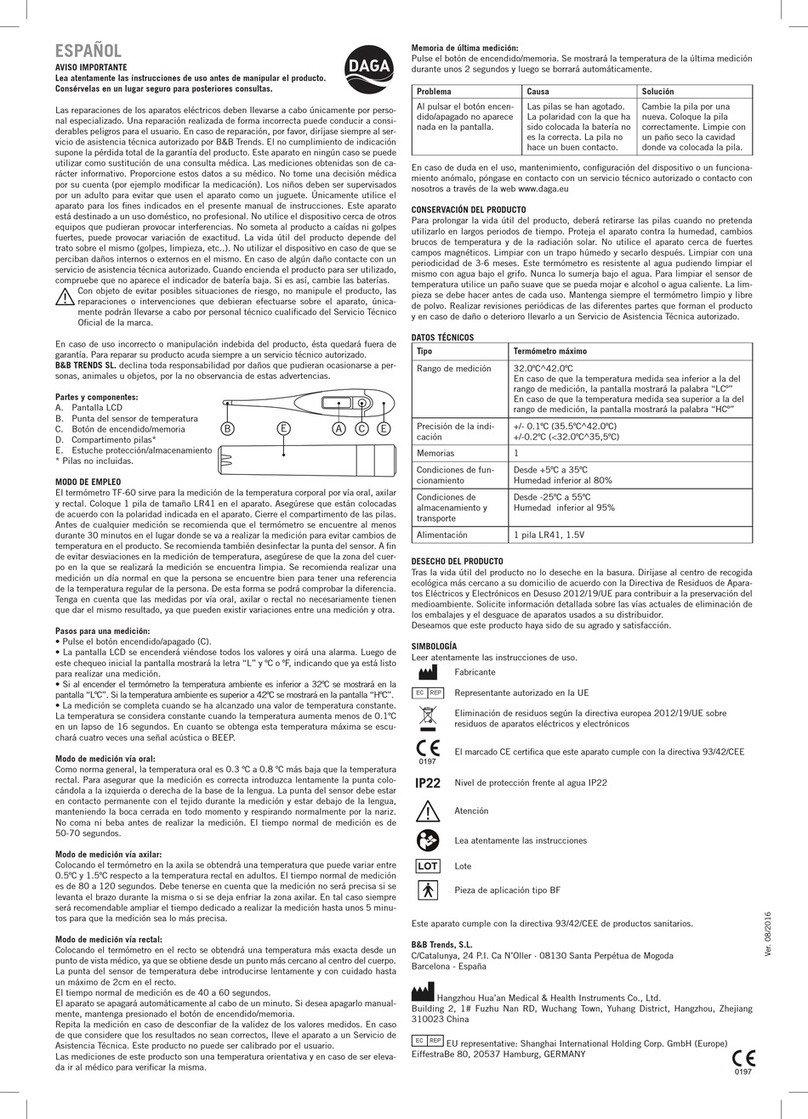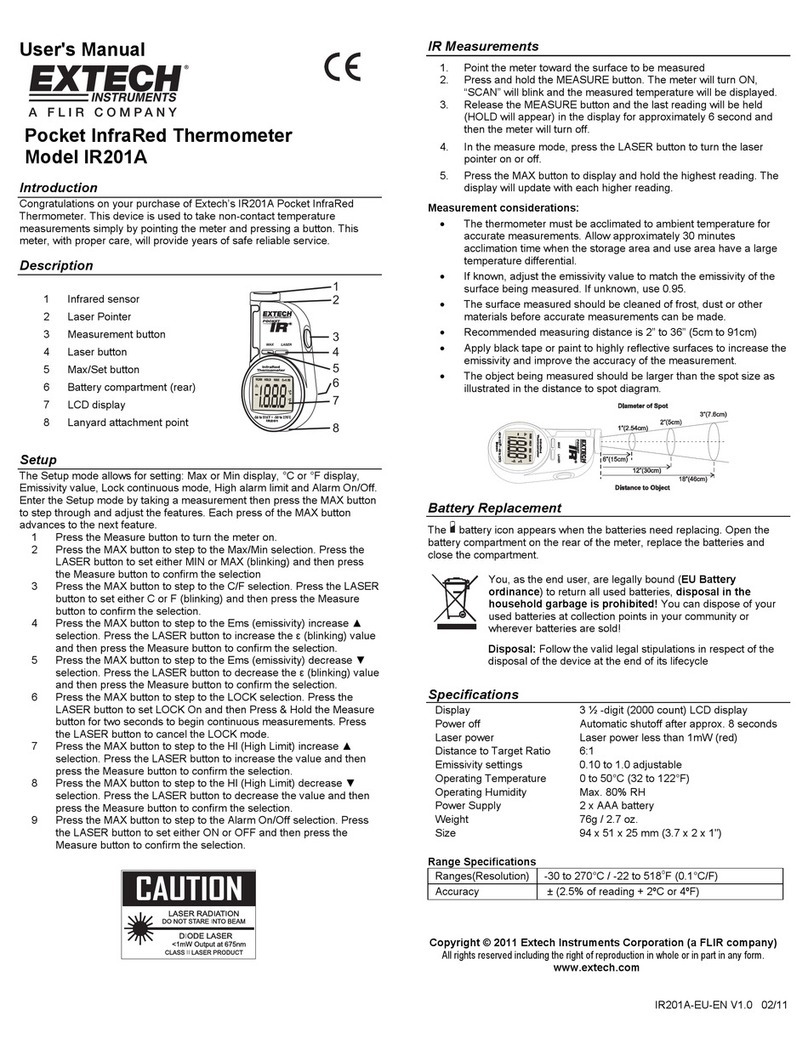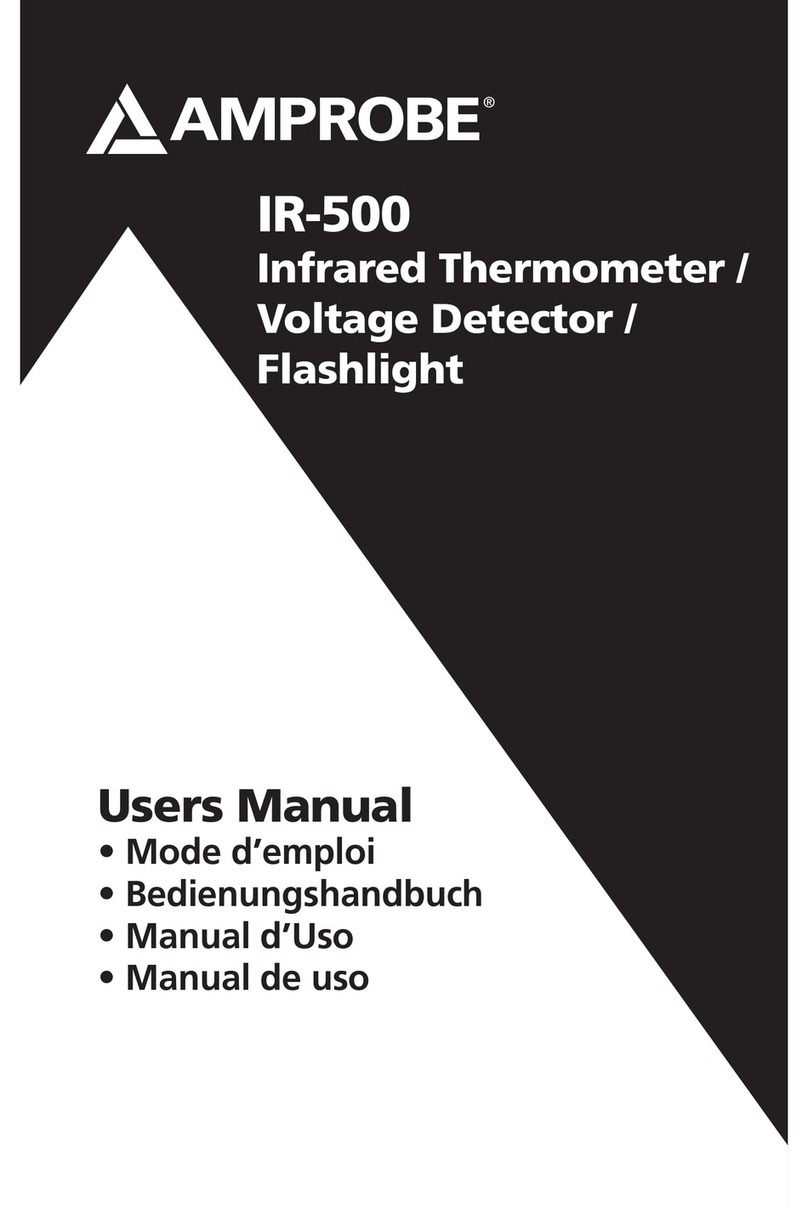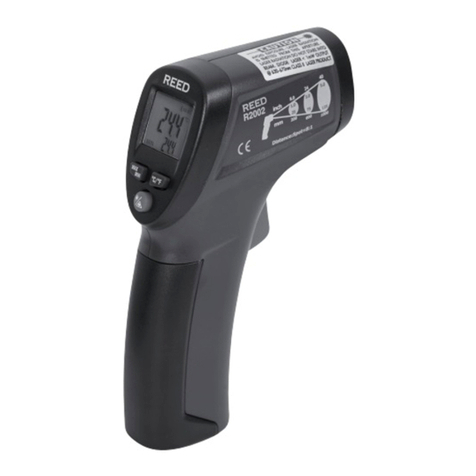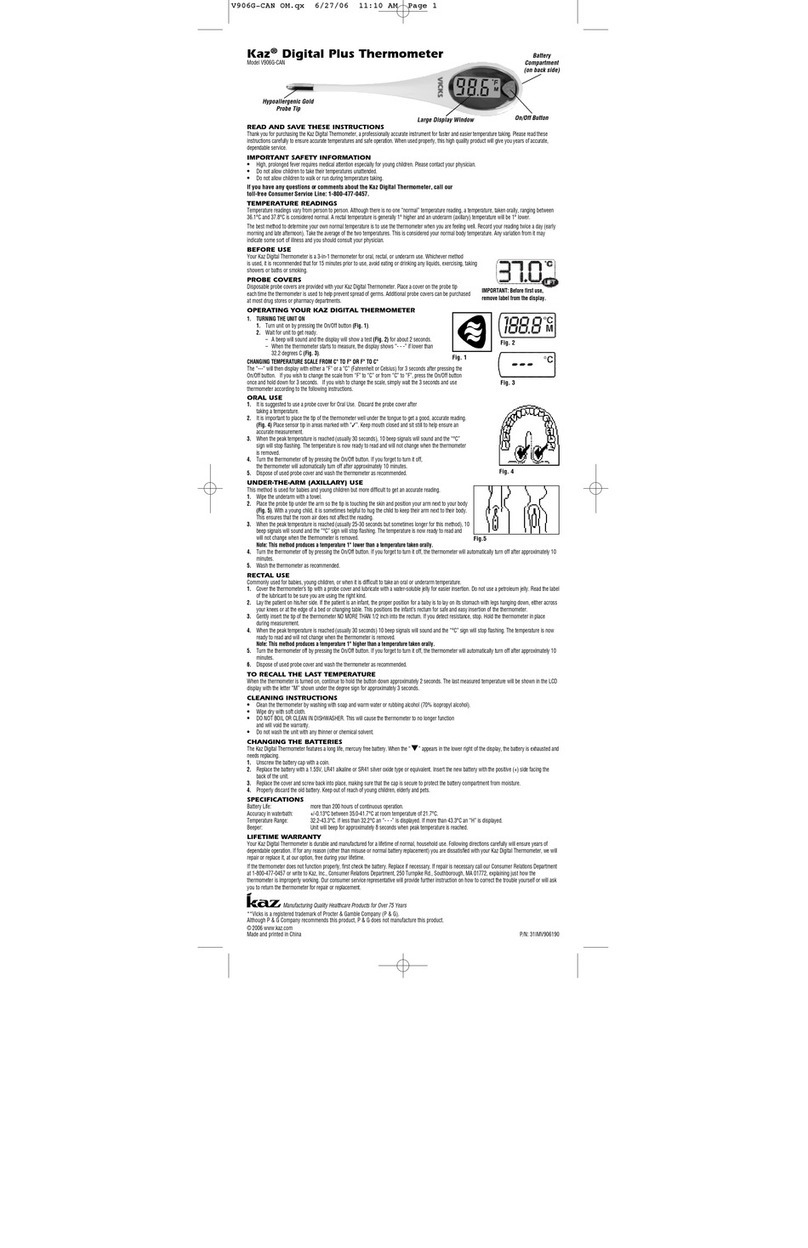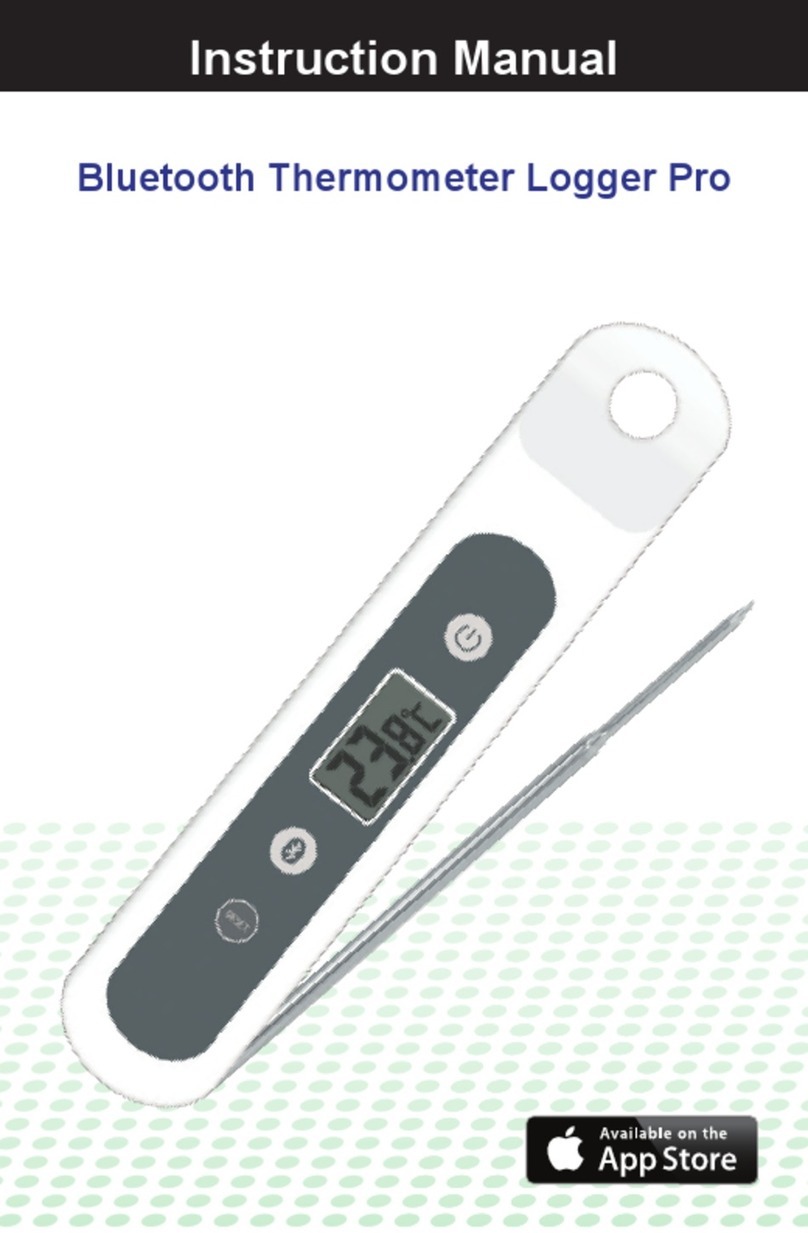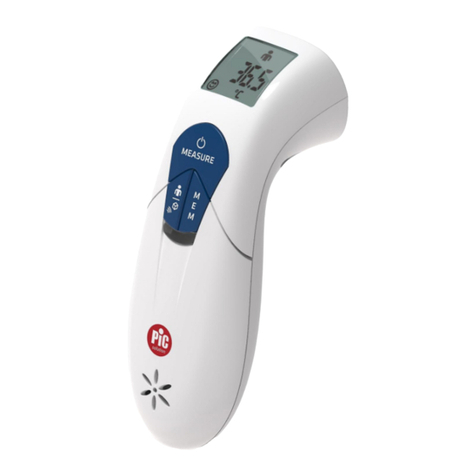MedSource MS-131002 User manual

User Manual
Non-Contact Infrared Body Thermometer
Model MS-131002
Please read this manual before operating this device.
It contains important safety information.
HTD8813C


Table of Contents
Foreword...........................................................................................................................................................3
Safety Information.......................................................................................................................................3
Warnings............................................................................................................................................................3
1 - Overview.....................................................................................................................................................4
2 - Operation...................................................................................................................................................7
3 - Troubleshooting.....................................................................................................................................12
4 – Replacing the Batteries.....................................................................................................................12
5 – Cleaning, Care and Storage..........................................................................................................13
6 – Disposal......................................................................................................................................................13
7 – Calibration................................................................................................................................................13
8– EMC Declaration.....................................................................................................................................14
01

Foreword
This user manual is intended to provide the necessary information for the proper operation of the model
MS-131002 non-contact infrared body thermometer.
A general knowledge of infrared thermometers and an understanding of the features and functions of
the thermometer are prerequisites for proper use.
The non-contact infrared body thermometer is a medical device designed to last for three years.
Please read this manual before using the thermometer. If you do not fully understand how to use the
thermometer, please consult this manual.
Do not operate the thermometer without completely reading and understanding
these instructions.
Warnings
Warnings are identified by the Warning symbol show above.
• The non-contact infrared body thermometer is to be operated by consumers in the home setting and
primary care setting as a screening tool. The manual, includes directions for use, all precautionary
information and specifications should be read before use.
• This thermometer is designed to measure human body temperature on the forehead. Do not use it for
any other purpose.
• This thermometer is intended to be used as a screening tool in a home setting and a primary care
setting.
• Do not use the thermometer if it malfunctions or has been damaged.
• If the ambient temperature changes too much, such as moving the thermometer from a cold room to a
warm room, allow the thermometer to adjust to the new temperature. This may take up to 30 minutes.
The operating temperature of the thermometer is 59 °F to 95 °F (15 °C to 35 °C).
• Remove the batteries if the thermometer is not likely to be used for a long time.
• The thermometer is not waterproof. Do not immerse it in water or other liquids. For cleaning and
disinfection, please follow the instructions contained in the “Cleaning, Care and Storage” section.
• Do not touch the infrared sensor with your fingers.
02
Safety Information
Notice
Purchase or possession of this device does not carry any express or implied license to use
with replacement parts which would, alone or in combination with this device, fall within the
scope of one of the relating patents.
This device should only be used for the purposes described in these instructions. The manufacturer
cannot be held liable for the damage caused by incorrect application.
The non-contact thermometer is designed to minimize the possibility of hazards from errors in the
software program by following human factors design, risk analysis, and software validation processes.

• If a cold compress has been applied to the patient’s forehead, or other physical measures have been
used to cool down the patient, avoid using the thermometer, as it may produce a low reading.
• When measuring body temperature using the forehead, select “body” mode. When measuring other
objects, liquids or foods, select “surface” mode.
• This product must be operated in a stable environment. If the ambient environment has changed, water
may condense on the surface of the infrared sensor. In the event of condensation on the infrared
sensor, see the “Cleaning, Care, and Storage” section for guidance.
• Do not use the thermometer near strong electrostatic or magnetic fields. These fields may aect the
accuracy of the thermometer.
• When replacing the batteries, do not mix old and new batteries. This may damage the thermometer.
• The accuracy of the measurement may be aected if the forehead is covered by hair, perspiration or
clothing.
• This thermometer is intended for screening. If you have any doubt about the result, please measure the
temperature using another method.
• The thermometer is calibrated during manufacturing. If used according to the instructions, periodic
calibration is not required.
The thermometer should be kept of the reach of children and pets. When not in use, store the
device in a dry place and protect it against moisture, heat, lint, dust and direct sunlight. Never
place any heavy objects on the thermometer or thermometer packaging.
Do not dispose of batteries in a fire.
Only use recommended batteries. Do not use rechargeable batteries.
This thermometer is not designed to replace diagnostic thermometers in hospitals.
Do not drop, disassemble or modify the thermometer.
Do not use the thermometer if you think it is damaged or notice unusual operation.
The thermometer is comprised of sensitive components and must be treated with caution.
Observe the storage and operating conditions described in the “Technical Specifications”
section.
Do not perform service or maintenance while the thermometer is on.
When using the thermometer, do not touch the battery and patient simultaneously.
Do not use the device if it is damaged/ degraded/ or if any of the thermometer has become
loose. The use of a damaged unit may cause improper results or injury.
Health Canada Warning: The thermometer is not intended for use on children under the age
of two.
Based on current science and technology, the thermometer is not known to cause any
allergic reactions.
This equipment needs to be installed and put into service in accordance with the information
provided in the ACCOMPANYING DOCUMENTS.
03

04
1 - Overview
Intended Use
The non-contact infrared body thermometer is designed to be used for intermittent measurement and
monitoring of human body temperature by consumers in the home setting and primary care setting as a
screening tool.
Description of Non-Contact Infrared Body Thermometer
Introduction and Operating Principle
This non-contact thermometer is a hand-held, reusable, battery-operated device which measures
human body temperature via the patient’s forehead.
The operating principle is based on infrared sensor technology. The infrared sensor can output
dierent signals when measuring dierent object temperatures or in dierent ambient temperatures.
An application-specific integrated circuit then turns the signal from the infrared sensor into a digital
value for display on the LCD screen.
Description of Controls, Indicators and Symbols
1. Liquid Crystal Display (LCD)
2. Battery Cover
3. On/Scan Button
4. Set Button
5. Memo Button
6. Mode Button
7. Infrared Sensor
1. Surface Mode
2. Body Mode
3. Digital Display
4. Fever Indicator
5. Battery Indicator
6. Buzzer On/O
7. Memory Index
8. Fahrenheit
9. Celsius
10. Memory Mode
Figure 1: Overview
Figure 2: Display

HTD8813C/MS-131002 Non-Contact Infrared Body Thermometer
Thermometer Applications
Equipment Symbols
Technical Specifications
Specification Value(s)
Measurement Units Fahrenheit (°F) / Celsius (°C)
Operating Mode Adjusted mode (Body mode)
Direct mode (Surface mode)
Measuring Site Forehead
Reference Body Site Axillary
Rated Output Range Body mode: 95.0 °F – 107.6 °F (35.0 °C – 42.0 °C)
Surface mode: 32.0 °F – 212.0 °F (0.0 °C – 100.0 °C)
Extended Output Range Body mode:
Lower: 93.2 °F – 94.8 °F (34.0 °C – 34.9 °C)
Upper: 107.8 °f – 109.2 °F (42.1 C 42.9 °C)
05
Thermometer
Model Number Thermometer
Adult Pediatric
Ear Forehead Ear Forehead
59º F
0%
85%
95º F
Warning
Non-Sterile Package
Refer to Operating Instructions
Operating Temperature
Operating Humidity
Manufacturer
Compliance with WEEE Standard
DO NOT THROW AWAY Intended for
multiple uses
Operating atmospheric pressure
Serial number
Recyclable
This device complies with Part 15 of
FCC (Federal Communications
Commission) rules.
Ingress Protection: The first 2 indicates protection from the ingress of solid foreign objects
12.5 mm in diameter and greater. The second 2 indicates protection from the ingress of
vertically falling water drops when the enclosure is tilted not greater than 15 degrees from
vertical.

Compliance
Basic Safety and Essential EN 60601-1: 2006+A1:2013, EN 60601-1-2:2007
Performance
Type of Protection Internally Powered Equipment (on battery power)
Degree of Protection Non-Applied Part
Range Body mode: 93.2 °F - 109.2 °F (34.0 °C - 42.9 °C)
Surface mode: 32.0 °F – 212.0 °F (0.0 °C – 100.0 °C)
Accuracy Body mode:
93.2 °F - 94.8 °F ±0.5 °F (34.0 °C - 34.9 °C ±0.3 °C)
95.0 °F – 107.6 °F ±0.4 °F (35.0 °C – 42.0 °C ±0.2 °C)
107.8 °F – 109.2 °F ±0.5 °F (42.1 °C – 42.9 °C ±0.3 °C)
Surface mode:
±3.6 °F (±2.0 °C)
Temperature Fahrenheit: 0.1
Resolution Celsius: 0.1
Three Color Backlight Green - Normal Temperature: 95.9°F – 99.2 °F (35.5 °C – 37.3 °C)
Yellow - Slight Fever: 99.3 °F – 100.4 °F (37.4 °C – 38.0 °C)
Red - High Fever: 100.5 °F – 109.2 °F (38.1 °C – 42.9 °C)
Notes: 1.Surface Mode always displays a green backlight.
2. In Body Mode, a reading of 93.2 °F – 95.8 °F
(34.0 °C – 35.4 °C) displays a green backlight.
Auto Power O ≤ 18 s
Measuring Time ≤ 2 s
Measuring Distance 0.4 – 2.0 in (1 – 5 cm)
Memory 50 measurements
06
Power Supply Requirements
Batteries 1.5V AAA Alkaline Battery x 2 (IEC Type LR03)
Adaptable Range 2.6V – 3.6V
Environmental Conditions
Operating Conditions Temperature: 59.0 °F – 95.0 °F (15.0 °C – 35.0 °C)
Relative Humidity: ≤ 85%
Atmospheric Pressure: 70 – 106 KPa
Transport and Storage Temperature: -4.0 °F – 131.0 °F (-20.0 °C – 55.0 °C)
Relative Humidity: ≤ 93%
Atmospheric Pressure: 70 – 106 KPa
Conditions
Weight
(without batteries) 3.0 ounces (84 grams)
Size Length: 5.4” (138mm)
Width: 3.7” (95mm)
Height: 1.6” (40mm)
Physical Properties
(Color Alarm)

Indicator Calculated Value
Clinical Bias (∆cb) -0.027 °C
Standard Deviation (σj) 0.14 °C
Limits of Agreement (LA) 0.26 °C
Clinical Repeatability (σr) 0.07 °C
07
2 - Operation
2.1 Battery Installation
1) Pull the battery cover forward as indicated by the arrow.
2) Insert two AAA-size batteries. Ensure correct polarity as indicated inside the
battery cover.
3) Slide the battery cover back in until it snaps in place.
2.2 Before Using the Thermometer
Be sure to read and understand all warnings listed in the instructions before use.
• If the ambient temperature changes too much, such as moving the thermometer from a cold room
to a warm room, allow the thermometer to adjust to the new temperature. This may take up to 30
minutes.
• The ambient temperature around the patient should be stable. Keep away from large air flows
such as fans or air-conditioning vents.
• Do not use the thermometer in bright sunlight.
• If a patient moves from a colder environment into a warmer test environment, they should remain
in the test environment for at least 5 minutes prior to taking a measurement. This will ensure the
patient is consistent with the ambient temperature.
Front Panel and Case Labeling EN/ISO 15223-1:2012
Temperature EN/ISO 80601-2-56:2012
Home Healthcare Environment EN 60601-1-11:2010
Calculated Values of the Indicators According to EN/ISO 80601-2-56
Safety Classification of ME Equipment
Protection against electric shock Internally Powered ME Equipment
Applied Part No Applied Parts
Protection against harmful ingress of IP22
water or particulate matter
Mode of Operation Continuous Operation
Note: Not intended to be sterilized. Not for use in an OXYGEN RICH ENVIRONMENT.

The thermometer should be kept of the reach of children and pets. When not in use, store the
device in a dry place and protect it against moisture, heat, lint, dust and direct sunlight. Never
place any heavy objects on the thermometer or thermometer packaging.
Do not dispose of batteries in a fire.
Only use recommended batteries. Do not use rechargeable batteries.
This thermometer is not designed to replace diagnostic thermometers in hospitals.
Do not drop, disassemble or modify the thermometer.
Do not use the thermometer if you think it is damaged or notice unusual operation.
The thermometer is comprised of sensitive components and must be treated with caution.
Observe the storage and operating conditions described in the “Technical Specifications”
section.
Do not perform service or maintenance while the thermometer is on.
When using the thermometer, do not touch the battery and patient simultaneously.
Do not use the device if it is damaged/ degraded/ or if any of the thermometer has become
loose. The use of a damaged unit may cause improper results or injury.
Health Canada Warning: The thermometer is not intended for use on children under the age
of two.
Based on current science and technology, the thermometer is not known to cause any
allergic reactions.
This equipment needs to be installed and put into service in accordance with the information
provided in the ACCOMPANYING DOCUMENTS.
08
2.3 Thermometer Self-Test
When the thermometer is o, press the On/Scan button to initiate a self-test. The thermometer will
briefly illuminate all segments of the display with green backlighting and then complete a measurement.
2.4 Temperature Modes
The thermometer is capable of measuring body temperature and surface temperature. By default,
the thermometer will enter Body Mode when turned on. To toggle between body temperature and
surface temperature, press the Mode Button when the device is on.
2.5 Body Temperature
Taking a Body Measurement
• Align the thermometer with the middle of the forehead to measure body temperature (between and
above the eyebrows).
• Ensure the distance between the thermometer and the patient’s forehead is between 0.4” and 2.0”
(1cm – 5 cm). See Figure 3.
Figure 3
• Press and release the On/Scan button.
• The measurement will be displayed within two seconds.
• The thermometer will produce an audible indication when the measurement is complete if audio is
enabled.
• Wait at least one second before taking the next measurement.
• If a continuous series of measurements is being performed, wait at least 30 seconds after every 5th
measurement.
Body Measurement Results
• If the measurement is below 93.2 °F (34.0 °C), the display will show “Lo”, a green backlight and beep
three times if audio is enabled.

09
• If the measurement is between 93.3 °F and 99.2 °F (34.1 °C and 37.3 °C) the display will show the
temperature, a green backlight, a happy face icon and beep once if audio is enabled. This indicates
normal body temperature.
• If the measurement is between 99.3 °F and 100.5 °F (37.4 °C and 38.0 °C), the display will show
the temperature, a yellow backlight, a sad face icon and emit a series of beeps if audio is enabled.
This indicates a slight fever
•If the measurement is between 100.6 °F and 109.2 °F (38.1 °C and 42.9 °C), the display will show
the temperature, a red backlight, a sad face icon and emit a series of beeps if audio is enabled.
This indicates a high fever.
• If the measurement is greater than 109.2 °F (42.9 °C), the display will show “Hi”, a green
backlight and beep three times if audio is enabled.
2.6 Surface Temperature
Taking a Surface Measurement
• Ensure the distance between the thermometer and the surface to be measured is between 0.4”
and 2.0” (1 cm and 5 cm).
• Press and release the On/Scan button.
• The measurement will be displayed within one second.
• The thermometer will produce a tone when the measurement is complete if audio is enabled.
Surface Measurement Results
• If the temperature is less than 32.0 °F (0.0 °C), the display will show “Lo”, a green backlight and
beep three times if audio is enabled.
• If the temperature is between 32.0 °F and 212.0 °F (0.0 °C and 100.0 °C), the display will show
the temperature, a green backlight and beep once if audio is enabled.
• If the temperature is greater than 212.0 °F (100.0 °C), the display will show “Hi”, a green backlight
and beep three times if audio is enabled.
2.7 Memory Mode
The thermometer will automatically store the previous 50 temperature measurements. Temperatures
that registered High or Low are out of range and are not stored.
• To enter Memory Mode, press the Memo Button while the unit is o or after the completion of a
temperature reading.
• Upon entering Memory Mode, the most recent temperature measurement will be displayed.
• Press the Memo Button to display the next temperature measurement.
• Each stored measurement will display the following information:
o The memory index value (1-50, newest to oldest).
o The temperature.

10
2.8 Parameter Mode
The thermometer has four parameters that can be tailored to certain populations or environmental
conditions.
Entering Parameter Mode
• Ensure the thermometer is on.
• Press and hold the Set Button until “F1” and then “Unit” is displayed.
Temperature Units (F1)
The thermometer can be set to display the temperature in Fahrenheit or Celsius.
• Press either the Memo Button or the Mode Button to toggle between Fahrenheit and Celsius.
• When the desired units have been selected, press the Set Button to move to the next parameter.
Fever Threshold (F2)
The thermometer allows the fever threshold to be modified. This is the value at which the thermometer
will indicate a slight fever. The default value is 100.5 °F.
• The threshold value will be displayed as it is modified.
• Press the Memo Button to increase the threshold by approximately 0.2 °F (0.1 °C).
• Press the Mode Button to decrease the threshold by approximately 0.2 °F (0.1 °C).
• When the desired threshold has been selected, press the Set Button to move to the next
parameter.
Audio (F3)
The thermometer can be used with audio enabled or disabled.
• Press either the Memo Button or the Mode Button to toggle between audio enabled and audio
disabled.
• When the desired audio setting has been selected, press the Set Button to move to the final
parameter.
Note: The audio can also be enabled and disabled via Set Button when not in Parameter Mode.
o The units (°F or °C).
o Whether body or surface temperature.
o For body temperature, a happy or sad face icon
• Every stored measurement will be displayed with a green backlight.
• To clear the stored values, press and hold the Memory Button until “Clr” is displayed.
• Empty memory cells will be displayed with “ - - - -“ as the temperature value.

11
Temperature Oset (F4)
The thermometer allows a surface temperature oset to be entered. This will increase or decrease the
displayed surface temperature, based on the oset value. The default oset value is zero. The oset
range is ± 9.0 °F (± 5.0 °C).
• The oset value is displayed as it is modified.
• Press the Memo Button to increase the oset by approximately 0.2 °F (0.1 °C).
• Press the Mode Button to decrease the oset by approximately 0.2 °F (0.1 °C).
• When the desired temperature oset has been selected, press the Set Button to exit Parameter
Mode.
2.9 Notes
• If you experience problems with this thermometer, such as configuration, maintenance or use,
please contact the SERVICE PERSONNEL. Do not attempt to open or repair the device
yourself.
• Please report to us any unexpected operation or events.
• The patient is an intended operator. They can determine the state of the batteries and change
the batteries. The patient can maintain the device and its accessories according to the user
manual under normal circumstances.

12
3 - Troubleshooting
4 – Replacing the Batteries
Caution: The thermometer does not operate with dead or low batteries and does not allow
connection to an external power supply.
1) Before replacing the batteries, ensure the device is o.
2) Pull the battery cover forward as indicated by the arrow.
3) Remove the old batteries.
4) Insert two AAA-size batteries. Ensure correct polarity as indicated inside the battery cover.
5) Slide the battery cover back in until it snaps in place.
6) Dispose of the batteries in accordance with local regulations.
The screen flickers and then
turns o.
Replace the batteries. If the error
persists, the device may be
damaged.
Replace batteries.
The ambient temperature has
changed too quickly.
Allow the thermometer to adjust
to the new temperature.
Blank Screen
a) The power is o
b) Improper battery installation
c) The batteries are depleted.
d) Device is damaged
a) Press the On/Scan button.
b) Check battery polarity.
c) Replace the batteries
d) Contact retailer or
service center.
Body: The temperature measured
is not within the typical human
body temperature range of
93.2 °F to 109.2 °F (34.0 °C to 42.9 °C).
Surface: The temperature measure
is not within the measurable range
of 32.0 °F – 212.0 °F (0.0 °C – 100.0 °C).
Ensure the correct distance and
location is being used to measure
the temperature.
Do not attempt to measure
temperatures outside the allowable
range.
Situation
Improper Distance Ensure the proper distance is
used: 0.4” – 2.0” (1 cm – 5 cm).
Incorrect test position.
The subject’s hair, antipyretic
stickers or perspiration is aecting
the measurement.
Remove any items that may
interfere with the measurement.
F4 temperature oset is set
incorrectly.
Adjust the temperature oset value.
The device temperature exceeds
the allowable operating
temperature range.
Move to a location within the
operating temperature range and
allow the thermometer
to adjust to the new temperature.
Message Solution
Ensure the correct position is used.
Battery capacity is too low.
Temperature measurement is
not allowed.

13
• Only use the recommended batteries.
• Do not attempt to recharge non-rechargeable batteries.
• Do not dispose of batteries in a fire.
• Remove the batteries if the thermometer is not to be used for a long period of time.
5 – Cleaning, Care and Storage
• It is important to protect the infrared lens from dirt and damage; it is very delicate.
• Use a clean, soft cloth to clean the surface of the device and LCD. Do not use solvents or immerse
the device in water or other liquids.
• Always keep the thermometer within the storage temperature range of -4.0 °F to 131.0 °F (-20.0 °
to 55.0 °C) and humidity range of ≤ 93% (non-condensing) as specified.
• It is recommended to store the thermometer in a dry location free from dust.
• Do not expose the thermometer to direct sunlight, high temperature or humidity or any other
extreme environmental conditions as it may aect the proper operation of the device.
• If the ambient temperature changes too much, such as moving the thermometer from a cold room
to a warm room, allow the thermometer to adjust to the new temperature. This may take up to 30
minutes. Condensation may have formed on the infrared sensor.
6 – Disposal
• Batteries should be disposed of in accordance with local regulations.
• Do not dispose of the thermometer in the unsorted municipal waste stream. Enquire about options
Warning
Do not recharge, disassemble, or dispose of in a fire.
• The typical service life for a set of new batteries is 2000 measurements with an operation time of 18
seconds per measurement.
If the device does not function after replacing the batteries:
• Check for proper battery polarity.
• Try a fresh set of batteries.
• The unit may have locked up if the batteries were removed while the unit was powered. In
this case, remove the batteries, wait 30 seconds, and then reinsert the batteries.
for environmentally friendly and appropriate disposal. Take local regulations into account.
7 – Callibration
The thermometer is initially calibrated at the time of manufacture. If this thermometer is used according to
the instructions, periodic re-adjustment is not required. If at any time you question the accuracy of the
temperature measurements, please contact service personnel.

14
7 – EMC Declaration
• This equipment needs to be installed and put into service in accordance with the information
provided in the ACCOMPANYING DOCUMENTS;This product needs special precautions regarding
EMC and needs to be installed and put into service according to the EMC information provided, and
this unit can be aected by portable and mobile RF communications equipment.
• Do not use a mobile phone or other devices that emit electromagnetic fields near the unit. This may
result in an incorrect operation of the unit.
• Caution: This unit has been thoroughly tested and inspected to assure proper performance and
operation.
• Caution: This machine should not be used adjacent to or stacked with other equipment and that if
adjacent or stacked use is necessary, this machine should be observed to verify normal operation in
the configuration in which it will be used.
Guidance and Manufacturer’s Declaration – Electromagnetic Immunity
The Non-Contact Infrared Body Thermometer is intended for use in the electromagnetic environments specified below. The
customer or user of the Non-Contact Infrared Body Thermometer should ensure that it is used in such an environment.
Power Frequency
(50 Hz/60 Hz)
Magnetic Field
IEC 61000-4-8
Electrostatic Discharge
(ESD)
IEC 61000-4-2
Electrical Fast
Transient/Burst
IEC 61000-4-4
Surge
IEC 61000-4-5
Voltage dips, short
interruptions and voltage
variations on power
supply input lines
IEC 61000-4-11
Immunity Test IEC 60601 Test Level
±6 kV contact
±8 kV air
±2 kV for power supply lines
±1 kV for input/output lines
±1 kV line(s) to line(s)
±2 kV for line(s) to earth
<5% UT (>95% dip in UT) for 0.5 cycle
40% UT (60% dip in UT) for 5 cycles
70% UT (30% dip in UT) for 25 cycles
<5% UT (>95% dip in UT) for 5 secs
3 A/m
Compliance Level
±6 kV contact
±8 kV air
Not Applicable
Not Applicable
Not Applicable
3 A/m
Floors should be wood, concrete or ceramic tile. If floors
are covered with synthetic material, the relative
humidity should be at least 30%.
Mains power quality should be that of a typical
commercial or hospital environment.
Mains power quality should be that of a typical
commercial or hospital environment.
Mains power quality should be that of a typical
commercial or hospital environment. If the user of
the Non-Contact Thermometer requires continued
operation during mains power interruption, it is
recommended that the device be powered from an
uninterruptable power supply or battery.
Power frequency magnetic fields should be at
levels characteristic of a typical location in a typical
commercial or hospital environment.
Note: UT is the AC mains voltage prior to application of the test level.

15
2.8 Parameter Mode
The thermometer has four parameters that can be tailored to certain populations or environmental
conditions.
Entering Parameter Mode
• Ensure the thermometer is on.
• Press and hold the Set Button until “F1” and then “Unit” is displayed.
Temperature Units (F1)
The thermometer can be set to display the temperature in Fahrenheit or Celsius.
• Press either the Memo Button or the Mode Button to toggle between Fahrenheit and Celsius.
• When the desired units have been selected, press the Set Button to move to the next parameter.
Fever Threshold (F2)
The thermometer allows the fever threshold to be modified. This is the value at which the thermometer
will indicate a slight fever. The default value is 100.5 °F.
• The threshold value will be displayed as it is modified.
• Press the Memo Button to increase the threshold by approximately 0.2 °F (0.1 °C).
• Press the Mode Button to decrease the threshold by approximately 0.2 °F (0.1 °C).
• When the desired threshold has been selected, press the Set Button to move to the next
parameter.
Audio (F3)
The thermometer can be used with audio enabled or disabled.
• Press either the Memo Button or the Mode Button to toggle between audio enabled and audio
disabled.
• When the desired audio setting has been selected, press the Set Button to move to the final
parameter.
Note: The audio can also be enabled and disabled via Set Button when not in Parameter Mode.
The Non-Contact Infrared Body Thermometer is intended for use in the electromagnetic environment
specified below. The customer or the user of the Non-Contact Infrared Thermometer should ensure that it is
used in such an
environment.
The Non-Contact Infrared Body Thermometer uses RF
energy only for its internal function. Therefore, its RF
emissions are very low and are not likely to cause any
interference in nearby electronic equipment.
The Non-Contact Infrared Body Thermometer is
suitable for use in al establishments, other than
domestic and those directly connected to the public
low-voltage power supply network that supplies
buildings used for domestic purposes.
Group 1
Class B
Not Applicable
Not Applicable
RF Emissions
CISPR 11
RF Emission
CISPR 11
Harmonic Emissions
IEC 6100-3-2
Voltage Fluctuations/
Flicker Emissions
IEC 61000-3-3
Guidance and Manufacturer’s Declaration – Electromagnetic Emission
Emission Test Compliance Electromagnetic Environment - Guidance
Portable and mobile RF communications equipment
should be used no closer to any part of the Non-Contact
Infrared Thermometer, including cables, than the
recommended separation distance calculated from the
equation applicable to the frequency of the transmitter.
Recommended Separation Distance
d = 1.2 √p (150 kHz – 80 MHz)
d = 1.2 √p (80 MHz – 800 MHz)
d = 1.2 √p (800 MHz – 2.5 GHz)
Where p is the maximum output power rating of the
transmitter in watts (W) according to the transmitter
manufacturer and d is the recommended separation
distance in meters.
Field strengths from fixed RF transmitters, as
determined by electromagnetic site surveysªshould be
less than the compliance level in each frequency
range. Interference may occur in the vicinity of
equipment marked with the following symbol:
The Non-Contact Infrared Body Thermometer is intended for use in the electromagnetic environments
specified below. The customer or user of the Non-Contact Infrared Body Thermometer should ensure that it
is used in such an environment.
Conducted RF
IEC 61000-4-6
3VRMS
150kHz to
80 MHz
Not
Applicable
Radiated RF
IRC61000-4-3 3 V/M
80MHz to
2.5 GHz
3 V/M
Guidance and Manufacturer’s Declaration – Electromagnetic Immunity
Electromagnetic Environment - GuidanceCompliance
Level
IEC 60601
Test Level
Immunity Test

Note 1: At 80 MHz and 800 MHz, the higher frequency range applies.
Note 2: These guidelines may not apply in all situations. Electromagnetic propagation is aected by
absorption and reflection from structures, objects and people.
a. Field strengths from fixed transmitters, such as base stations for radio (cellular/cordless) telephones
and land mobile radios, amateur radio, AM and FM radio broadcast and TV broadcast cannot be
predicted theoretically with accuracy. To assess the electromagnetic environment due to fixed RF
transmitters, an electromagnetic site survey should be considered. If the measured field strength in the
location in which the device is used exceeds the applicable RF compliance level above, the device
should be observed to verify normal operation. If abnormal performance is observed, additional
measures may be necessary, such as reorienting or relocating the device.
b. Over the frequency range 150 kHz to 80 MHz, field strengths should be less than 3 V/m.
16
Recommended Separation Distances between
Portable and Mobile RF Communications Equipment and the Non-Contact Infrared Thermometer
The Non-Contact Infrared Thermometer is intended for use in an electromagnetic environment in which
radiated RF disturbances are controlled. The customer or user of the device can help prevent
electromagnetic interference by maintaining distance between portable and mobile RF communications
equipment (transmitters) and the device as recommended below, according to the maximum output power
of the communications equipment.
Rated Maximum Output
Power of Transmitter (W)
Separation distance according to frequency of transmitter (m)
150 kHz – 80 MHz
d = 1.2√p
80 MHz – 800 MHz
d = 1.2√p
800 MHz – 2.5 GHz
d = 2.3√p
0.01
0.1
1
10
100
0.12
0.38
1.2
3.8
12
0.12
0.38
1.2
3.8
12
0.23
0.73
2.3
7.3
23
For transmitters rated at a maximum output power not listed above, the recommended separation distance (d) in meters
(m) can be estimated using the equation applicable to the frequency of the transmitter, where p is the maximum output
power rating of the transmitter in watts (W) according to the transmitter manufacturer.
Note 1: At 80 MHz and 800 MHz, the separation distance for the higher frequency applies.
Note 2: These guidelines may not apply in all situations. Electromagnetic propagation is aected by the absorption and
reflection from structures, objects and people.


MANUFACTURED FOR :
MEDSOURCE
4201 NOREX DRIVE
CHASKA, MN 5531 8
800-876-8264
info@medsourcelabs .com ww w.medsourcelabs.com
REV. 1
This manual suits for next models
1
Table of contents
Other MedSource Thermometer manuals
